Fisheries production posts 24.6 percent growth in 2024
In 2024, the total fisheries production increased to 24,752.64 metric tons, marking a 24.6 percent growth from 19,867.92 metric tons in 2023. This overall increase was primarily driven by a significant increase in the commercial fisheries subsector, which grew by 202.3 percent, from 4,346.51 metric tons to 13,138.68 metric tons in 2024.
Figure 1. Volume of Fisheries Production (in MT) by Subsectors:
Aklan, 2023 and 2024
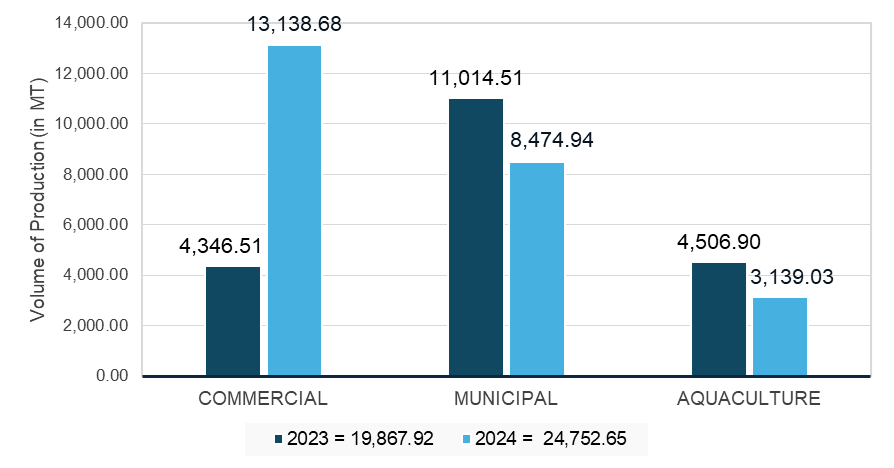
Source: Philippine Statistics Authority
In contrast, the municipal fisheries subsector declined by 23.1 percent, dropping from 11,014.51 metric tons in 2023 to 8,474.94 metric tons in 2024. The aquaculture subsector likewise recorded a downturn, with production decreasing by 30.4 percent, from 4,506.90 metric tons in 2023 to 3,139.03 metric tons in 2024.
Of the total production in 2024, commercial fisheries accounted for the largest share at 53.1 percent, followed by municipal fisheries at 34.2 percent, and aquaculture at 12.7 percent.
Figure 2. Percentage Distribution of Volume of Fisheries Production
by Subsector, Aklan: 2024
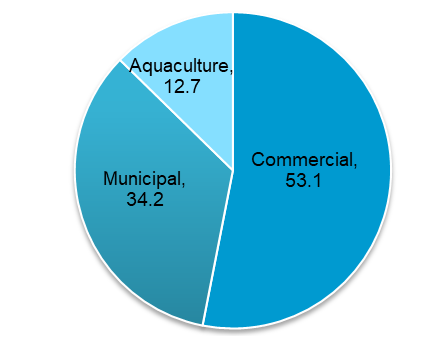
Source: Philippine Statistics Authority
In contrast, the municipal fisheries subsector declined by 23.1 percent, dropping from 11,014.51 metric tons in 2023 to 8,474.94 metric tons in 2024. The aquaculture subsector likewise recorded a downturn, with production decreasing by 30.4 percent, from 4,506.90 metric tons in 2023 to 3,139.03 metric tons in 2024.
The value of fishery products reached PhP 2.91 billion, with an average price of PhP 117.66 per kilogram. This represents a 20.1 percent increase in total output value compared to PhP 2.42 billion in 2023. Meanwhile, the average price per kilogram declined by 3.6 percent, from PhP 122.06 to PhP 117.66.
Volume of catch by commercial boats reached 13,138.68 metric tons
The commercial fisheries subsector in Aklan recorded a remarkable increase in catch volume, reaching 13,138.68 metric tons in 2024.
Value of fish was estimated at PhP 1.58 billion, corresponding to an average price of PhP 120.42 per kilogram. This is 2.44 percent lower than the PhP 123.43 per kilogram reported in 2023.
Figure 3. Most Caught Species in Commercial Fisheries Subsector:
Aklan, 2023 and 2024
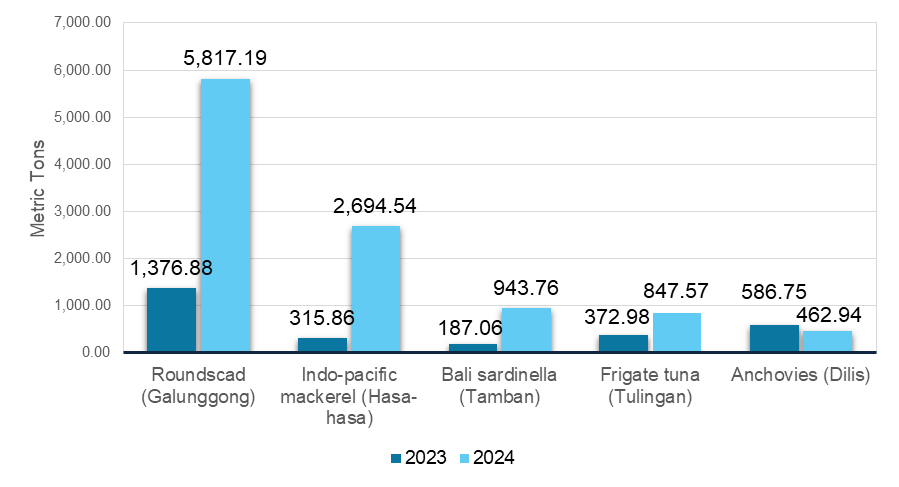
Source: Philippine Statistics Authority
Of the fish species contributing to this subsector’s output, Roundscad (Galunggong) recorded the highest production in 2024 at 5,817.19 metric tons, up from 1,376.88 metric tons in 2023. Followed by Indo-Pacific mackerel (Hasa-hasa) with 2,694.54 metric tons, a significant increase from 315.86 metric tons. Bali sardinella (Tamban) and Frigate tuna (Tulingan) also showed notable increases, reaching 943.76 and 847.57 metric tons respectively. Anchovies (Dilis), in contrast, declined from 586.75 to 462.94 metric tons.
Municipal Fish Catch Falls to 8,474.94 metric tons
The municipal fisheries reported a total production of 8,474.94 metric tons in 2024, marking a 23.1 percent decline from the 11,014.51 metric tons recorded in 2023.
Municipal fisheries experienced a 28.7 percent decline in production value from PhP 1.52 billion to PhP 1.08 billion, while the average price per kilogram dropped by 7.38 percent, from PhP 137.85 to PhP 127.67.
Figure 4. Volume of Production of Municipal Fisheries
by Sector, Aklan: 2024
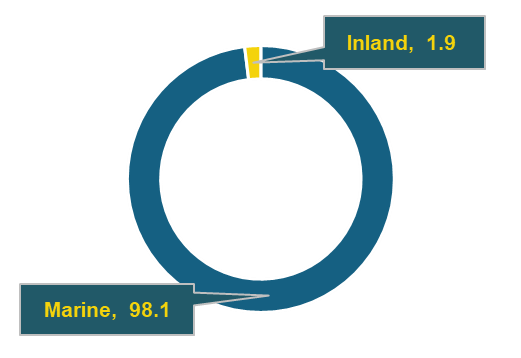
Source: Philippine Statistics Authority
Within the municipal subsector, both marine and inland fisheries experienced decreases. Marine fisheries maintained a dominant share of the total production at 98.1 percent, while inland fisheries accounted for the remaining 1.9 percent.
Marine Fish Catch and Value Fall in 2024
Marine fisheries fell by 19.6 percent from 10,338.69 metric tons in 2023 to 8,310.14 metric tons in 2024.
Value of marine fisheries was estimated at PhP 1.06 billion, with an average price of PhP 127.60 per kilogram. This reflects a 7.35 percent decrease from the PhP 137.72 per kilogram recorded in 2023.
Figure 5. Most Caught Species in Marine Municipal Fisheries:
Aklan, 2023 and 2024
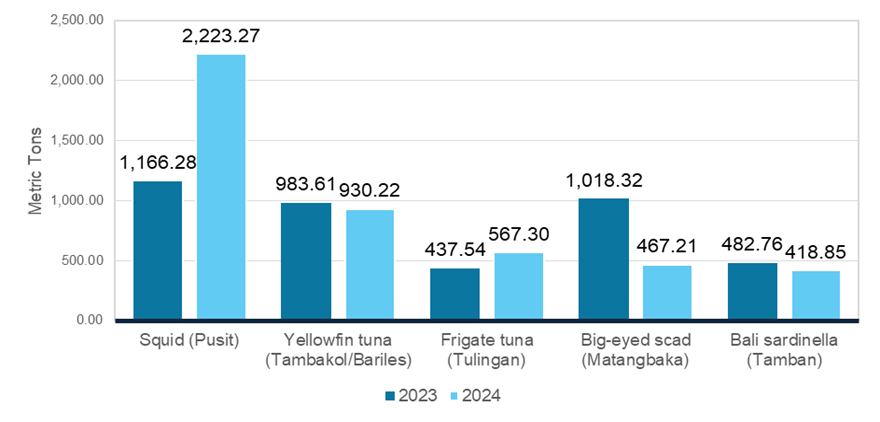
Source: Philippine Statistics Authority
Main species caught in marine municipal fisheries include Squid (Pusit), which became the leading species in 2024, with production rising sharply from 1,166.28 metric tons in 2023 to 2,223.27 metric tons in 2024, marking a 90.6 percent increase. Frigate tuna (Tulingan) also recorded positive growth of 29.7 percent, increasing from 437.54 metric tons to 567.30 metric tons. However, other key species experienced declines in production. Big-eyed scad (Matangbaka) had the sharpest drop at 54.1 percent, from 1,018.32 metric tons to 467.21 metric tons. Yellowfin tuna (Tambakol/Bariles) also decreased by 5.4 percent, from 983.61 metric tons to 930.22 metric tons, while Bali sardinella (Tamban) dropped by 13.2 percent, from 482.76 to 418.85 metric tons.
Inland fisheries face substantial decline
Inland fisheries experienced a significant decline in 2024, with total production dropping by 75.6 percent, from 675.83 metric tons in 2023 to 164.79 metric tons in 2024.
Figure 6. Most Caught Species in Inland Municipal Fisheries:
Aklan, 2023 and 2024
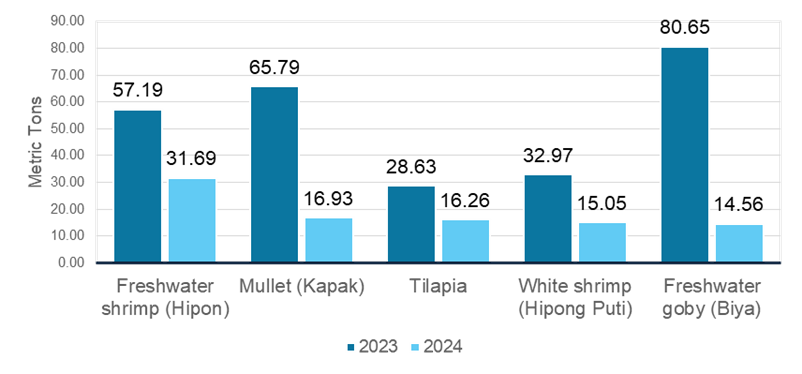
Source: Philippine Statistics Authority
Inland fisheries value of production dropping by 77. 1 percent, from PhP 94.48 million in 2023 to only PhP 21.62 million in 2024. The average price per kilogram of inland fishery products also fell by 6.14 percent, from PhP 139.80 in 2023 to PhP 131.23 in 2024.
Among the major species, Freshwater shrimp (Hipon) posted a 44.6 percent decline, falling from 57.19 metric tons to 31.69 metric tons, yet remained the top contributor, accounting for 19.2 percent of total inland catch. Mullet (Kapak) and Tilapia also saw notable drops of 74.3 percent and 43.2 percent, respectively, contributing 10.3 percent and 9.9 percent of total production. White shrimp (Hipong Puti) went down 54.4 percent from 32.97 metric tons to 15.05 metric tons. Freshwater goby (Biya) showed the most significant drop in output, decreasing by 81.9 percent, from 80.65 metric tons in 2023 to just 14.56 metric tons in 2024.
Aquaculture Production in Aklan Drops by 30.4 percent in 2024
Aklan’s aquaculture fishery production in 2024 went down by 30.4 percent, from 4,506.90 metric tons in the previous year to 3,139.03 metric tons.
Among the different aquafarm types, brackish water fishponds had the highest production, contributing 2,120.61 metric tons or 67.6 percent of the total. This was distantly followed by oyster farms with 775.74 metric tons and brackish water pens with 178.42 metric tons. Other contributors included freshwater fishponds (29.12 metric tons), brackish water cages (23.05 metric tons), mussel farms (7.50 metric tons), seaweed farms (2.80 metric tons), and freshwater pens (1.76 metric tons).
Value of production in aquaculture had a 33.0 percent drop, from PhP 370.19 million in 2023 to PhP 248.14 million in 2024. The average price per kilogram declined by 3.76 percent, from PhP 82.14 to PhP 79.05.
Figure 7. Most Harvested Species in Aquaculture Fisheries Subsector:
Aklan, 2023 and 2024
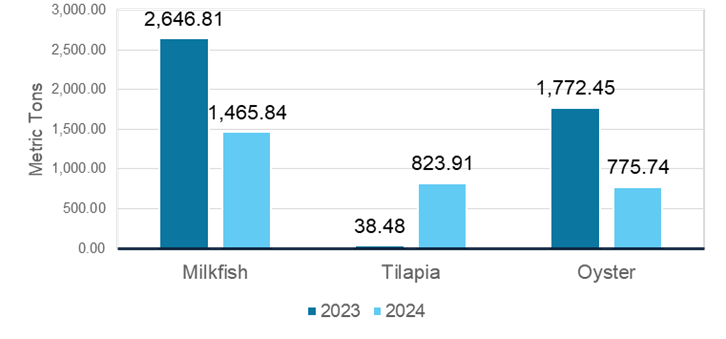
Source: Philippine Statistics Authority
Among the species cultivated, milkfish remained the top contributor, accounting for 1,465.84 metric tons or 46.7 percent of the total aquaculture output. However, this represented a significant 44.6 percent decline from the 2,646.81 metric tons recorded in the previous year. Tilapia ranked second with 823.91 metric tons, making up 26.2 percent, followed closely by oyster with 775.74 metric tons, contributing 24.7 percent to the overall production.
Table 1. Volume of Fisheries Production (in MT) by Subsectors:
Aklan, 2023 and 2024
Subsectors | Volume of Production (in Metric Tons) | Growth Rates (in percent) | |
2023 | 2024 | ||
Total | 19,867.92 | 24,752.64 | 24.6 |
Commercial | 4,346.51 | 13,138.68 | 202.3 |
Municipal | 11,014.51 | 8,474.94 | -23.1 |
Marine | 10,338.69 | 8,310.14 | -19.6 |
Inland | 675.82 | 164.79 | -75.6 |
Aquaculture | 4,506.90 | 3,139.03 | -30.4 |
Note: Total may not sum up due to rounding off
Source: Philippine Statistics Authority
Table 2. Value of Fisheries Production and Average Price per Kilo by Subsectors: Aklan, 2023 and 2024
Subsectors | Value of Production | Growth Rates on Average Prices (in percent) | |||
2023 | Average Price per kilogram (in PhP) | 2024 | Average Price per kilogram (in PhP) | ||
Total | 2,424,993,300.00 | 122.06 | 2,912,289,210.00 | 117.66 | -3.60 |
Commercial | 536,500,540.00 | 123.43 | 1,582,142,110.00 | 120.42 | -2.44 |
Municipal | 1,518,305,000.00 | 137.85 | 1,082,011,690.00 | 127.67 | -7.38 |
Marine | 1,423,823,150.00 | 137.72 | 1,060,387,070.00 | 127.60 | -7.35 |
Inland | 94,481,850.00 | 139.80 | 21,624,620.00 | 131.23 | -6.14 |
Aquaculture | 370,187,760.00 | 82.14 | 248,135,410.00 | 79.05 | -3.76 |
Source: Philippine Statistics Authority
Table 3. Volume of Production of Most Caught Species in Commercial Fisheries: Aklan, 2023 and 2024
Species | Volume of Production (in Metric Tons) | Growth Rates (in percent) | |
2023 | 2024 | ||
Total | 4,346.52 | 13,138.72 | 202.3 |
Roundscad (Galunggong) | 1,376.88 | 5,817.19 | 322.5 |
Indo-pacific mackerel (Hasa-hasa) | 315.86 | 2,694.54 | 753.1 |
Bali sardinella (Tamban) | 187.06 | 943.76 | 404.5 |
Frigate tuna (Tulingan) | 372.98 | 847.57 | 127.2 |
Anchovies (Dilis) | 586.75 | 462.94 | -21.1 |
Others | 1,506.99 | 2,372.72 | 57.4 |
Source: Philippine Statistics Authority
Table 4. Volume of Production of Most Caught Species in Marine Municipal Fisheries: Aklan, 2023 and 2024
Species | Volume of Production (in Metric Tons) | Growth Rates (in percent) | |
2023 | 2024 | ||
Total | 10,338.69 | 8,310.14 | -19.6 |
Squid (Pusit) | 1,166.28 | 2,223.27 | 90.6 |
Yellowfin tuna (Tambakol/Bariles) | 983.61 | 930.22 | -5.4 |
Frigate tuna (Tulingan) | 437.54 | 567.30 | 29.7 |
Big-eyed scad (Matangbaka) | 1,018.32 | 467.21 | -54.1 |
Bali sardinella (Tamban) | 482.76 | 418.85 | -13.2 |
Others | 6,250.18 | 3,703.29 | -40.7 |
Source: Philippine Statistics Authority
Table 5. Volume of Production of Most Caught Species in Inland Municipal Fisheries: Aklan, 2023 and 2024
Species | Volume of Production (in Metric Tons) | Growth Rates (in percent) | Percent Share (in percent) | |
2023 | 2024 | |||
Total | 675.83 | 164.79 | -75.6 | 100.0 |
Freshwater shrimp (Hipon) | 57.19 | 31.69 | -44.6 | 19.2 |
Mullet (Kapak) | 65.79 | 16.93 | -74.3 | 10.3 |
Tilapia | 28.63 | 16.26 | -43.2 | 9.9 |
White shrimp (Hipong Puti) | 32.97 | 15.05 | -54.4 | 9.1 |
Freshwater goby (Biya) | 80.65 | 14.56 | -81.9 | 8.8 |
Others | 410.60 | 70.30 | -82.9 | 42.7 |
Source: Philippine Statistics Authority
Table 6. Volume of Production of Most Caught Species in Aquaculture Fisheries: Aklan, 2023 and 2024
Species | Volume of Production (in Metric Tons) | Growth Rates (in percent) | Percent Share (in percent) | |
2023 | 2024 | |||
Total | 4,506.89 | 3,139.02 | -30.4 | 100.0 |
Milkfish | 2,646.81 | 1,465.84 | -44.6 | 46.7 |
Tilapia | 38.48 | 823.91 | 2,041.1 | 26.2 |
Oyster | 1,772.45 | 775.74 | -56.2 | 24.7 |
Others | 49.15 | 73.53 | 49.6 | 2.3 |
Source: Philippine Statistics Authority
TECHNICAL NOTES
The Fisheries Situation Report was derived from the four (4) major surveys --- the Quarterly Commercial Fisheries Survey (QCFS), Quarterly Municipal Fisheries Survey (QMFS), Quarterly Inland Fisheries Survey (QIFS), and Quarterly Aquaculture Survey (QAqS). These surveys aim to provide quarterly data on volume and value of fish production by species and by environment.
Commercial fishing – cover fishing operations in marine waters that make use of boats of more than three gross tons.
Marine Municipal Fishing – covers fishing operation carried out with or without the use of a boat weighing three (3) gross tons or less.
Inland Municipal Fishing – is the catching of fish, crustaceans, molluscs and all other aquatic animals and plants in inland water like lakes, rivers, dams, marshes, etc. using simple gears and fishing boats, some of which are nonmotorized with a capacity of three (3) gross tons or less; or fishing not requiring the use of fishing boats.
Aquaculture – is a fishery operation involving all forms of raising and culturing of fish and other fishery species in fresh, brackish and marine water areas.
Aquafarm – is a farming facility used in the culture or propagation of aquatic species including fish, mollusk, crustaceans, and aquatic plants for purposes of rearing to enhance production.
Fishpond – refers to a land-based type of aquafarm; a body of water (artificial or natural) where fish and other aquatic products are cultured, raised or cultivated under controlled conditions.
Fish Pen – refers to an artificial enclosure constructed within a body of water for culturing fish and fishery/aquatic resources made up of bamboo poles closely arranged in an enclosure with wooden materials, screen or nylon netting to prevent escape of fish.
Fish Cage – refers to a stationary or floating fish enclosure made of synthetic net wire/bamboo screen or other materials set in the form of inverted mosquito net (“hapa” type) with or without cover with all sides either tied to poles staked to the water bottom or with anchored floats for aquaculture purposes.
Oyster Farm – is an aquafarm involved in the cultivation of oyster in shallow brackish or marine area by any method for production purposes.
Mussel Farm – is an aquafarm involved in the cultivation of mussel in shallow brackish or marine area by any method for production purposes.
Seaweed Farm – is an aquafarm involved in the cultivation of seaweed in suitable water areas by any methods with appropriate intensive care for production in commercial quantities.
ENGR. ANTONET B. CATUBUAN
Chief Statistical Specialist
Aklan Provincial Statistical Office
Philippine Statistics Authority

